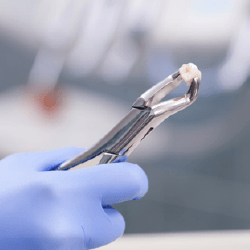Tooth Extractions – Sugar Land, Texas
Keep Your Smile Healthy
 Removing natural teeth is not something we recommend lightly. Whenever possible, we will repair your damaged tooth and renew full oral health and function. However, there are some situations where tooth removal is the best choice to ensure you maintain the optimal level of oral health. If you need to have one or more teeth removed, the skilled dentist and dentistry team at Eco Dental can help. We offer both surgical and nonsurgical tooth extraction to help patients maintain their healthiest smiles. To learn more about tooth extractions, tooth replacement options, and other services available, call our dental office to schedule your restorative dentistry consultation today.
Removing natural teeth is not something we recommend lightly. Whenever possible, we will repair your damaged tooth and renew full oral health and function. However, there are some situations where tooth removal is the best choice to ensure you maintain the optimal level of oral health. If you need to have one or more teeth removed, the skilled dentist and dentistry team at Eco Dental can help. We offer both surgical and nonsurgical tooth extraction to help patients maintain their healthiest smiles. To learn more about tooth extractions, tooth replacement options, and other services available, call our dental office to schedule your restorative dentistry consultation today.
Why Would I Need a Tooth Removed?

If it’s possible, we will preserve healthy dental structure with restorative dentistry services like dental crowns to repair damage. When repairing the tooth isn’t the best option for your smile, our team will recommend extractions. Some of the reasons for these procedures include:
- Damaged or decayed teeth that can’t be repaired may be removed.
- A child’s primary teeth that don’t fall out on their own may need to be extracted.
- Impacted teeth, those that are unable to erupt on their own, may need to be surgically removed.
- Prior to orthodontic treatment when crowding is a concern, one or more teeth may need to be removed before we begin treatment to align teeth.
- Before designing or placing a partial or full denture, damaged or compromised teeth may need to be removed.
- The most commonly removed teeth are wisdom teeth, third molars. Their late eruption in the smile can cause the teeth to be impacted or shift surrounding teeth out of alignment.
How are Teeth Extracted?
 A fixed bridge is a solution to replace one, two, or several consecutively missing teeth. Dental bridges are often made from sturdy and natural-looking porcelain fused-to-metal. This type of restoration works like an actual bridge -- two crowns are placed on the teeth that surround the gap, and the pontics (replacement teeth) are attached to the crowns. They fill in the gap left by missing teeth.
A fixed bridge is a solution to replace one, two, or several consecutively missing teeth. Dental bridges are often made from sturdy and natural-looking porcelain fused-to-metal. This type of restoration works like an actual bridge -- two crowns are placed on the teeth that surround the gap, and the pontics (replacement teeth) are attached to the crowns. They fill in the gap left by missing teeth.
We will either “pull” or surgically remove the teeth. Pulling teeth, or nonsurgical extraction, is only a possibility for teeth that have fully emerged from the gums. To pull these teeth, we numb the area around the tooth to be extracted. Then, we use a clasp tool to shift the tooth back and forth until it breaks free from the gum and bone structures. When pulling isn’t possible, we’ll need to surgically extract the tooth. This may be as simple as cutting away soft tissue to reveal the tooth below, or more advanced surgical intervention may be necessary, including drilling into supportive bone structure or breaking the tooth into smaller pieces.
What Happens After Tooth Extraction?
 A fixed bridge is a solution to replace one, two, or several consecutively missing teeth. Dental bridges are often made from sturdy and natural-looking porcelain fused-to-metal. This type of restoration works like an actual bridge -- two crowns are placed on the teeth that surround the gap, and the pontics (replacement teeth) are attached to the crowns. They fill in the gap left by missing teeth.
A fixed bridge is a solution to replace one, two, or several consecutively missing teeth. Dental bridges are often made from sturdy and natural-looking porcelain fused-to-metal. This type of restoration works like an actual bridge -- two crowns are placed on the teeth that surround the gap, and the pontics (replacement teeth) are attached to the crowns. They fill in the gap left by missing teeth.
After your tooth or teeth are removed, one of our team members will walk you through caring for your smile as you heal to ensure you make a full recovery. This process can take a few weeks, but you should begin to notice significant improvement after the first two days. Throughout the healing process, you should feel a little better each day. If you notice increased discomfort or bleeding doesn’t stop after the first few days, you should call our team. We’ll do our best to help you relieve pain and complete the healing process.
